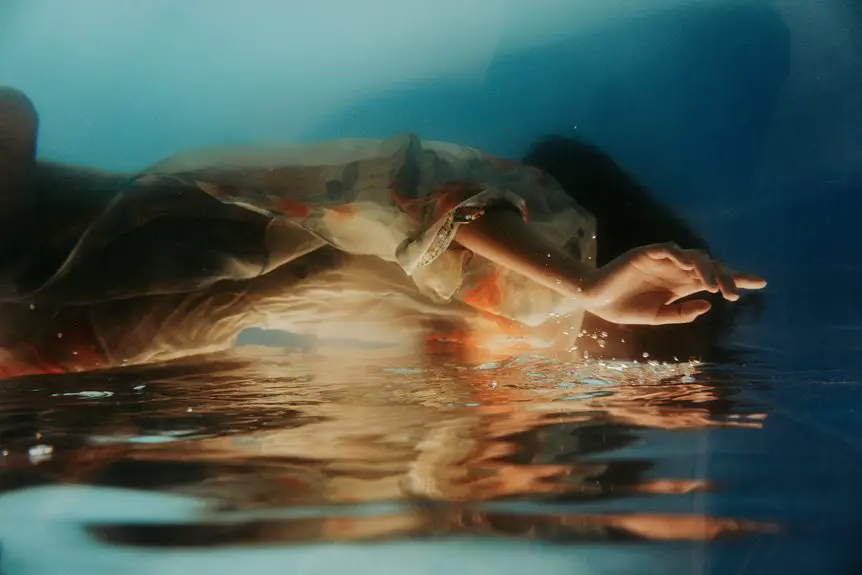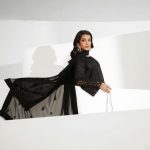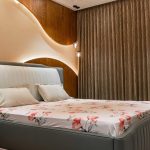To control and diffuse natural light using scrim fabric, set it taut between your light source and subject to soften harsh sunlight and reduce glare. Adjust its distance and angle to balance light intensity and shadow softness. Use lighter or denser fabrics based on how much diffusion you need, and secure the scrim to prevent movement outdoors. This technique creates flattering, even illumination—perfect for portraits and creative effects—and there’s more to explore about setup and maintenance.
Table of Contents
Key Takeaways
- Position scrim fabric taut between the light source and subject to soften harsh sunlight and reduce shadows effectively.
- Adjust the scrim’s distance from the subject to control light diffusion intensity and achieve desired softness.
- Secure scrim with clamps or clips outdoors to prevent movement and maintain consistent light diffusion.
- Use different mesh densities to vary diffusion levels, from fine mesh for soft portraits to coarse mesh for creative shadows.
- Tilt or angle the scrim to modulate light direction, creating balanced highlights and enhancing image depth.
Understanding the Benefits of Scrim Fabric in Photography
Although you mightn’t have used scrim fabric before, it offers several key benefits that can enhance your photography.
You can easily control natural light, softening harsh shadows and reducing glare without relying on artificial sources. This fabric helps you create a more even and flattering illumination, which is especially useful for portraits and close-up shots.
You’ll appreciate its lightweight and portable nature, making it simple to carry and set up on location. Plus, scrim fabric is versatile—it lets you modify light intensity without changing its color temperature, preserving the scene’s natural feel.
Different Types of Scrim Fabric and Their Uses
You’ll find scrim fabrics come in lightweight and heavyweight options, each shaping your light differently.
Color variations can add unique effects, while mesh density controls how much light gets softened or blocked.
Knowing these differences helps you pick the right scrim for your shot.
Lightweight vs. Heavyweight Scrims
Two main categories of scrim fabric—lightweight and heavyweight—offer distinct advantages depending on your photography needs.
Lightweight scrims are easy to carry and set up, making them perfect for outdoor shoots where portability matters. They diffuse light softly, reducing harsh shadows without completely blocking sunlight.
Heavyweight scrims, on the other hand, are more durable and block more light, giving you greater control over exposure and contrast. Use them when you need to create more defined shadows or when working in windy conditions, as they resist flapping better.
Understanding these differences helps you choose the right scrim to shape natural light precisely, enhancing your images according to the mood and style you want to achieve.
Color Variations and Effects
Beyond weight and durability, scrim fabrics come in various colors that influence the quality and mood of your lighting.
White scrims create soft, neutral diffusion, perfect for natural, flattering light. Silver or reflective scrims bounce light, enhancing brightness without harsh shadows.
Black scrims don’t diffuse light but instead block or flag unwanted light, helping you control spill and contrast.
Colored scrims, like amber or blue, subtly tint your light, adding warmth or coolness to your scene.
Choosing the right scrim color helps you set the tone and feel of your photos without additional post-processing.
Experiment with different hues to see how they shape your images, giving you creative control over natural light’s character.
Mesh Density and Light Diffusion
Although scrim fabrics come in various colors, their mesh density plays an essential role in how they diffuse light. You’ll find that tighter meshes soften light more, creating a gentle, even glow. Looser meshes let more light through but with less diffusion, which can add subtle texture or shadow detail to your shots. Choosing the right mesh density depends on your lighting needs and the effect you want to achieve.
| Mesh Density | Light Diffusion Level | Ideal Use |
|---|---|---|
| Fine | High | Portraits, soft natural lighting |
| Medium | Moderate | General diffusing, outdoor shoots |
| Coarse | Low | Dramatic shadows, creative effects |
Understanding these options helps you control natural light precisely.
Choosing the Right Scrim Fabric for Your Shoot
When selecting scrim fabric for your shoot, you’ll want to evaluate the material’s weight, weave, and translucency to achieve the desired lighting effect.
Lightweight fabrics with a loose weave provide softer diffusion, letting more light through while reducing harsh shadows. Heavier or tighter weaves offer stronger light control but may darken your scene more than intended.
Consider the color as well; white scrims maintain natural color balance, while neutral gray ones can slightly reduce overall brightness without altering tones.
Also, think about the size of the scrim relative to your setup—larger scrims create broader, more even light diffusion, ideal for full-body or group shots.
Ultimately, choose scrim fabric that matches your lighting goals and shooting environment for the best results.
How Scrim Fabric Diffuses Harsh Sunlight
When you place scrim fabric between your subject and the sun, it softens direct sunlight to create a more even light.
This helps reduce harsh shadows that can distract from your composition.
You’ll also notice less glare, making your photos look cleaner and more professional.
Softening Direct Sunlight
Since harsh sunlight can create unflattering shadows and blown-out highlights, using scrim fabric helps you soften the light effectively. By placing the scrim between the sun and your subject, you scatter the direct rays, creating a gentle, even glow. This reduces contrast and delivers a more flattering image.
| Step | Action | Result |
|---|---|---|
| 1 | Position scrim | Blocks harsh rays |
| 2 | Adjust distance | Controls softness level |
| 3 | Secure fabric | Maintains consistent light |
| 4 | Observe effect | Achieves balanced exposure |
Using scrim fabric this way transforms glaring sunlight into soft, natural illumination perfect for portraits and outdoor shoots.
Reducing Shadows and Glare
Although harsh sunlight can create unwanted shadows and glare, you can easily reduce these issues by using scrim fabric.
When you place scrim between the sun and your subject, it diffuses the light, softening sharp shadows that might otherwise distract from your composition. This diffusion also cuts down on glare, which often causes overexposed highlights or lens flares.
By scattering sunlight evenly, scrim fabric helps you achieve balanced lighting without harsh contrasts. You don’t need bulky equipment—just a simple scrim panel or frame positioned to block direct rays.
Adjust its distance to control the softness. Using scrim fabric this way lets you maintain natural light’s beauty while keeping your images clean, detailed, and free from distracting shadows and glare.
Setting Up Scrim Fabric for Outdoor Photography
Setting up scrim fabric for outdoor photography requires careful attention to location and lighting conditions to maximize its effectiveness.
First, choose a spot where sunlight is harsh or uneven. Secure the scrim between two sturdy supports, like light stands or trees, ensuring it’s taut but not stretched too tight.
Select a spot with harsh sunlight and secure the scrim tautly between sturdy supports like stands or trees.
Position the fabric between the sun and your subject to soften direct sunlight and reduce harsh shadows. Use clamps or clips to prevent the scrim from shifting in the wind. If you’re working in a breezy area, weigh down the stands for stability.
Always check the fabric’s angle relative to the sun for even diffusion. This setup lets you control natural light, creating softer, more flattering illumination outdoors.
Positioning Scrim Fabric for Window Light Diffusion
When positioning scrim fabric for window light diffusion, you’ll want to find the ideal distance to soften the light without losing its natural direction.
Moving the scrim closer or farther from the window changes how evenly the light spreads across your subject.
Also, pay attention to the angles of the incoming light to control shadows and highlights effectively.
Optimal Scrim Placement
Because scrim fabric softens and diffuses harsh window light, placing it correctly is essential to achieve the ideal lighting effect. Start by positioning the scrim directly between the window and your subject to evenly spread the light across their features.
Verify it covers the entire window to avoid uneven patches of brightness. Secure the scrim taut to prevent wrinkles that cause unwanted shadows or light distortions. If your window is large, use multiple scrims side by side for consistent diffusion.
Avoid placing the scrim too close to the subject, as this can flatten the light, removing natural shadows and depth. Instead, keep it close enough to diffuse but far enough to maintain dimension.
Proper placement helps you capture soft, natural-looking images with balanced highlights and shadows.
Adjusting Distance Effects
Although placing the scrim correctly is essential, adjusting the distance between the scrim and your subject can dramatically change the quality of light you capture.
When you move the scrim closer to your subject, the light becomes softer and more diffused, reducing harsh shadows and creating a gentle, flattering effect.
Pulling the scrim farther away results in a broader, less intense diffusion, which can add subtle texture and dimension.
Experiment with varying distances to find the balance between softness and light spread that suits your scene.
Keep in mind, as you increase distance, the scrim covers a larger area of the window, influencing overall exposure.
Managing Light Angles
Adjusting the angle of your scrim fabric plays an essential role in shaping how window light interacts with your subject. By tilting or repositioning the scrim, you can control the direction and softness of the light hitting your scene.
If you place the scrim perpendicular to the window, it diffuses light evenly. Tilting it slightly changes the light’s angle, creating subtle shadows or highlights that add depth. Experiment with angles to reduce harsh reflections or brighten shadowed areas without losing softness.
Keep in mind, small adjustments can drastically affect your image’s mood. Position the scrim so it blocks direct, intense rays but still allows a natural, flattering glow.
Managing light angles this way helps you achieve balanced, professional-looking photos with natural window light.
Techniques for Adjusting Light Intensity With Scrims
When you place a scrim between your light source and subject, you immediately soften and reduce the light’s intensity without changing its color temperature. To adjust intensity, vary the distance between the scrim and your subject or light. Closer scrims diffuse more, while moving them away lets more light through. You can also layer scrims for greater diffusion or use different fabric densities to fine-tune brightness.
| Technique | Effect on Light Intensity | Notes |
|---|---|---|
| Move scrim closer | Decreases sharply | Stronger diffusion |
| Move scrim farther | Decreases slightly | Softer diffusion |
| Layer multiple scrims | Greater reduction | Use for very bright light |
| Choose fabric density | Controls diffusion amount | Lightweight = less diffusion |
Combining Scrim Fabric With Reflectors and Other Tools
To get the most out of scrim fabric, pair it with reflectors and other light-shaping tools. Use a scrim to soften harsh sunlight, then position a reflector to bounce light back onto your subject, filling in shadows and adding dimension.
Reflectors come in various colors—white for soft fill, silver for contrast, and gold for warmth—so choose based on your desired mood. You can also combine scrims with flags or black cards to block unwanted spill or create deeper shadows.
When working outdoors, clamps and stands help secure your scrim and reflectors in place, ensuring consistent light control. Experiment with angles and distances to balance diffusion and reflection effectively, giving you greater creative control over natural light in your photography.
Creative Effects Achievable With Scrim Fabric
Although scrim fabric’s primary role is to diffuse light, it also lets you achieve a variety of creative effects that can transform your photos. You can use it to create soft, dreamy backgrounds by placing the scrim between the subject and a busy backdrop, blurring distractions without harsh shadows.
Positioning scrim fabric at an angle can introduce subtle gradients of light, adding depth and mood to your shots. You can also partially cover your lens with scrim for a gentle glow effect around highlights.
Experiment with layering scrims to vary diffusion intensity, producing unique textures and tones. By creatively manipulating scrim placement, you gain control over light’s quality and direction, allowing you to craft images that feel natural yet artistically refined.
Maintaining and Caring for Your Scrim Fabric
Since scrim fabric plays an essential role in shaping your photos, taking proper care of it guarantees consistent performance and longevity.
Always store your scrim in a clean, dry place, folded or rolled loosely to avoid creases and damage. After each shoot, gently brush off dust or debris with a soft cloth.
Store scrims clean and dry, loosely folded or rolled, and gently brush off dust after each use.
If you need to clean it, hand wash using mild soap and cold water, then air dry flat or hang it to prevent wrinkles. Avoid harsh chemicals or machine washing, which can degrade the fabric.
When setting up or breaking down, handle the scrim carefully to prevent tears or stretching. Following these simple steps assures your scrim stays in top condition, ready to deliver beautiful, diffused light every time you shoot.
Troubleshooting Common Issues When Using Scrims
When you work with scrims, you might encounter issues like uneven light diffusion, fabric wrinkles, or unexpected shadows.
To fix these, try the following:
- Uneven Diffusion: Adjust the distance between the scrim and your light source or subject. Moving it closer or farther can balance the light spread.
- Fabric Wrinkles: Stretch the scrim taut using clamps or a frame to eliminate wrinkles that cause uneven lighting.
- Unexpected Shadows: Check for objects casting shadows behind or around the scrim. Reposition the scrim or adjust your light angles to avoid these.
Tips for Transporting and Storing Scrim Fabric Efficiently
Fixing issues like wrinkles and shadows often means handling your scrim fabric carefully. To keep it in top shape, roll it instead of folding to avoid creases. Store it in a breathable bag to prevent moisture buildup. When transporting, use a padded case to protect against tears and dirt. Label your scrims by size or type for quick access.
| Tip | Benefit |
|---|---|
| Roll fabric | Prevents wrinkles |
| Use breathable storage bag | Avoids moisture damage |
| Transport in padded case | Protects from physical harm |
| Label scrims | Saves setup time |
Frequently Asked Questions
Can Scrim Fabric Be Used for Video Lighting as Well as Photography?
Absolutely, you can use scrim fabric for video lighting too. It softens harsh light and reduces shadows, giving your footage a professional, natural look. Just position it between the light source and your subject for best results.
What Are the Environmental Impacts of Producing Scrim Fabric?
Before smartphones, you’d consider scrim fabric’s environmental impact: it often involves synthetic fibers, energy-heavy production, and chemical dyes. You can choose eco-friendly options or recycle to minimize harm and keep your shoots greener.
How Does Scrim Fabric Compare to Professional Light Diffusers in Cost?
You’ll find scrim fabric is usually cheaper than professional light diffusers. It offers an affordable way to soften light, though diffusers might provide more consistent results and durability, making scrims great for budget-conscious photographers.
Are There Any DIY Alternatives to Commercial Scrim Fabric?
You might think commercial scrim fabric is irreplaceable, but you can DIY alternatives using sheer curtains, white bedsheets, or nylon mesh. These materials diffuse light effectively while saving money, though they might lack professional durability and finish.
Can Scrim Fabric Be Used in Studio Settings With Artificial Lights?
Yes, you can use scrim fabric in studio settings with artificial lights. It softens and diffuses harsh light, reducing shadows and creating a more flattering, even illumination for your subjects, enhancing your overall image quality.
- Where to Buy Sherpa Suede Fabric - July 12, 2025
- How to Draw or Illustrate the Texture of Suede Fabric - July 12, 2025
- What Is Baseball Suede Leather Fabric? - July 12, 2025







